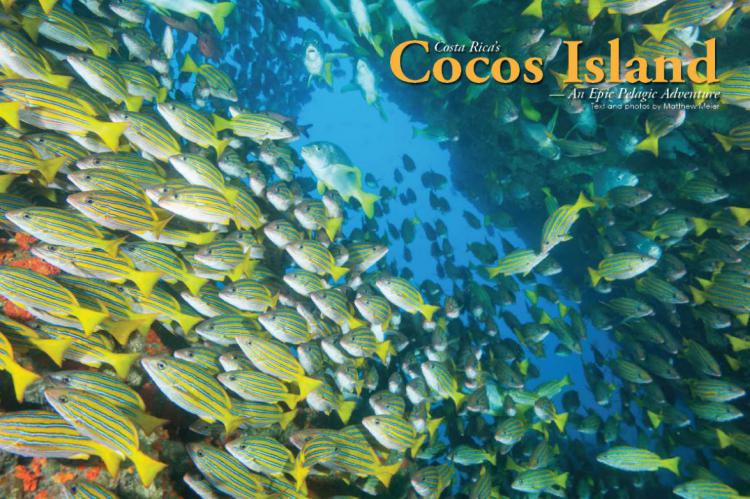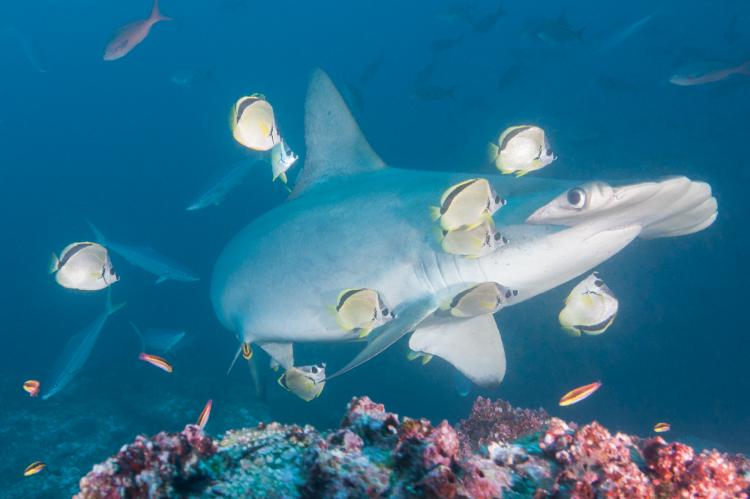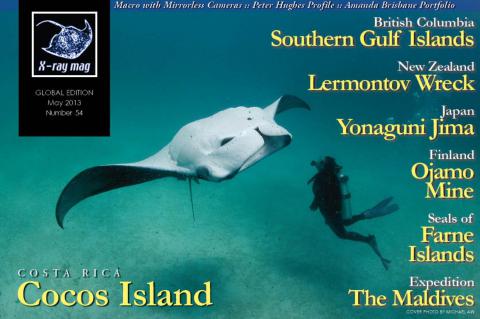Cocos Island — An Epic Pelagic Adventure
Tucked behind rocks at 90 feet, my fellow divers and I were getting restless hoping for a visit from hammerheads or one of the resident tiger sharks, neither of which were cooperating. The dive master motioned for the group to follow, as he headed to another cleaning station and perhaps better luck. As I turned to make sure the videographer to my right got the signal, I saw him kicking in the opposite direction to deeper water.
Tags & Taxonomy
Figuring he saw something worth pursuing, I swam blindly after him through the haze of a shimmering thermocline. Emerging out the other side onto the sandy bottom at 104 feet, I was staring at my very first tiger shark as it swam past the videographer and straight towards me.
Instinctively reversing course in shock and with a slight pucker factor, I not so gracefully stumbled backwards over some rocks and fell flat on my butt. So much for those amazing tiger shark photos I had envisioned while staring with anticipation into the blue.
Happily all was not lost, the shark turned above me, seemingly oblivious to my plight, and continued on a wide circle that would bring it around for another pass between the videographer and myself. This time I managed to keep myself upright and captured a photo of the tiger as it slowly swam past the videographer—tiger shark 1, photographer 1.
Such is the diving at Cocos Island, where periods of waiting are punctuated by heart-stopping big animal interactions.
Cocos Island
Cocos Island, or Isla del Coco as it is known locally, first became part of Costa Rica in 1832. It is uninhabited, except for a small group of national park rangers. The island became a Costa Rican national park in 1978 and was designated a World Heritage Site by UNESCO in 1997. The marine zone around Cocos Island was added to the World Heritage Site designation in 2002. Legend states that over the years, numerous pirates buried treasure on Cocos Island, though despite several extensive searches, none has been recovered.
Irregular in shape, Cocos Island has an area of approximately 9.2 square miles (23.85 squ km). Cocos is tectonic and volcanic in origin, primarily composed of basalt. The island is incredibly green and lush due to its wet climate and is covered in tropical forests and cloud forests at elevations above 500m. The cloud forest ecosystem is unique to Cocos Island and does not exist on any other island in the Eastern Pacific Ocean. Of the four mountain peaks on the island, the highest is Cerro Iglesias at 2,080 ft (634m). The mountainous landscape and abundant rainfall creates dozens of waterfalls, which drain off every side of the island.
Rich marine life
Cocos is perhaps best known for its sharks, with hundreds of schooling scalloped hammerhead and silky sharks, innumerable whitetip reef sharks, Galapagos, silvertip and now tiger sharks. It is also not uncommon to see whale sharks, manta rays and dolphins. The fish life here is incredibly abundant and the main reason these apex predators are so prevalent.
Sightings of jacks and snappers in schools that block out the sun are routine. The ample marine life surrounding Cocos Island is attracted to the nutrient-rich ocean currents that swirl around this small island 340 miles west of Costa Rica in the Eastern Pacific Ocean.
Accessible only by liveaboard dive boat, this remote island requires a 32- to 36-hour transit across potentially angry seas for the privilege of diving this holy grail of pelagic encounters. Once in the water, the currents can be fierce and more than once I had to pull myself down the mooring line just to get to a dive site
( ... )
Download the full article ⬇︎

Originally published
X-Ray Mag #54
Diving Cocos Island; British Columbia's Southern Gulf Islands; Seals of Farne Islands; The Lermontov Wreck off New Zealand; Japan's Yonaguni Jima; Finland's Ojamo Mine; Expedition to the Maldives; Dive Fitness Programs for Divers; Scuba Instructor Training; Tech: Self-Sufficiency vs Team Diving; Macro with Mirrorless Cameras; Peter Hughes Profile; Frozen Water: Amanda Brisbane's Sand Cast Glass; Plus news and discoveries, equipment and training news, books and media, underwater photo and video equipment, turtle news, shark tales, whale tales and much more...































